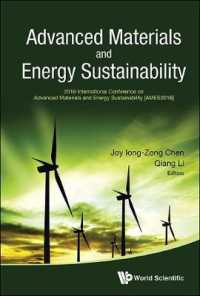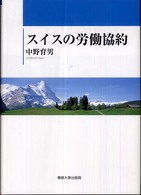- ホーム
- > 洋書
- > 英文書
- > Literary Criticism
Full Description
In Kanbunmyaku: The Literary Sinitic Context and the Birth of Modern Japanese Language and Literature, Saito Mareshi demonstrates the centrality of Literary Sinitic poetry and prose in the creation of modern literary Japanese. Saito's new understanding of the role of "kanbunmyaku" in the formation of Japanese literary modernity challenges dominant narratives tied to translations from modern Western literatures and problematizes the antagonism between Literary Sinitic and Japanese in the modern academy. Saito shows how kundoku (vernacular reading) and its rhythms were central to the rise of new inscriptional styles, charts the changing relationship of modern poets and novelists to kanbunmyaku, and concludes that the chronotope of modern Japan was based in a language world supported by the Literary Sinitic Context.
Contents
Editors' Preface: Saitō Mareshi, the "Literary Sinitic Context," and Literary Modernity in the Former Sinographic Cosmopolis
Author's Preface to the English Edition
List of Illustrations
Introduction
1 What Is the Literary Sinitic Context?: Two Poles of Style and Thought
1 Japan's Literary Sinitic Context
2 Two Poles of Style and Thought
3 Outline of the Literary Sinitic Context in Its Regional and Temporal Dimensions
4 Literary Sinitic Cultivation
5 The Kansei Reforms
6 The Formation of Literati Consciousness
7 Common Ground for Warriors and Literati
8 How Literary Sinitic Was Studied
9 The Style for Discussion of State Affairs
10 The Patriotic Lamentations of Men of High Purpose in the Late Edo Period
11 The Death Poem of Kondō Isami
2 Why Did the Reading and Writing of Kanbun Spread?—The Unofficial History of Japan and the Voice of Kundoku
1 Kanbun as a Written Language
2 Rai San'yō and His Scholarly Lineage
3 The System of Neo-Confucian Zhu Xi Studies
4 The "Prohibition of Heterodoxy" and the Institutionalization of Learning
5 Learning and the Orientation toward Governance
6 The Grand Ambition of Historical Narrative
7 The Completion of the Unofficial History of Japan
8 Reasons for Bestsellerhood
9 Reading-Conscious Kanbun
10 Criticism of Washū
11 Kundoku Rhythm as Different from Ordinary Speech
12 Vernacular Reading (Kundoku) and Sinoxenic Vocalization (Ondoku)
13 Famous, Captivating Melodies
14 The Shigin Trend
15 The Charm of Grandiose Kanshi
16 The Literary Sinitic Context Popularized
3 The Formation of a National Literary Style: The Civilization and Enlightenment Movement and Kundokubun
1 The Separation of Literary Sinitic and Kundokubun
2 Meiji-Period Evaluations of San'yō
3 Differences in the Three Appraisals
4 What Is "Futsūbun"?
5 Two Points of Focus: A Text's Functionality versus Its Moral Spirit
6 Universal and Common
7 Kundoku as Inscriptional Style
8 The Gradual Dilution of Kanbun's Mental World
9 A Style Fit for Translation
10 A Time for Utility and Practicality
11 Contemporary Style as Modern Style
12 The Rise of "a Compositional Style for the Populace"
13 A Massive Lexicon of Sinographic Coinages
14 The Writing Style of Enlightenment
15 Rhetorical Kundoku Style: A True Account of America and Europe
16 Sophisticated Contemporary Style
4 When Did the "Modern" Begin in Japanese Literature?: Romantic Love as the Antithesis of Politics
1 Calling into Question "Modern Literary History"
2 Coteries of Kanshi Poets during Meiji
3 Mori Shuntō, Leading Contributor to the Thriving of Kanshi
4 The Public and the Private as Constituents of the Mental World
5 Devotion to the Private World
6 The Literati Mentality: Cherishing Literary Sinitic Poetry and Prose
7 Ōnuma Chinzan in the World of the Literatus
8 The Polarity of "Politics = Public" vs. "Literature = Private"
9 The Separation of Literature from Learning
10 Mori Ōgai's Diary of a Westbound Voyage (Kōsei nikki)
11 Mori Ōgai's Self-Consciousness
12 The Framework of Official Career vs. Reclusion
13 Exaggerated Rhetoric
14 The Motif of "The Dancing Girl" (Maihime)
15 The Origins of Renown and Diligent Study
16 Romantic Love as the Antithesis of Politics
17 The Reorganization of "Literature"
5 Japanese Novelists, Nostalgia, and the Exotic: China as the Land of Romantic Love and Revolution
1 The Position of Novels in the Early Modern Period
2 The Relative Status of Poetry and Fiction
3 The Theme of "Emotion"
4 Romantic Love and the Political Novel
5 A Great Compendium of Romantic Fiction
6 A New Focus for Fiction: The Replication of "Human Emotion"
7 Nagai Kafū, Child of a Scholar-Official
8 Diametrically Opposed Father and Son
9 From Prodigal Son to Spitting Image of His Father
10 Consciousness of Foreign Lands Nurtured by Interactions with Qing China
11 Intoxication with Shanghai
12 Reality Seeps into Kanshibun
13 Kafū within the Literary Sinitic Context
14 Tanizaki Jun'ichirō, Child of a Merchant Household
15 Drowning Single-Mindedly in Beauty
16 Shina as the Setting for Eros
17 Akutagawa's Realistic Conception of China
18 Contrasting Tanizaki and Akutagawa
19 What Was the Taishō Ideology of Education?
6 The Horizon of Literary Sinitic: From the Literary Sinitic Context to a New Kind of Japanese Language
1 Characteristics of the Genbun itchi (Congruence of Speech and Writing) Style
2 Stepping Outside the Literary Sinitic Context
3 The Focus of Écriture
4 The Struggle of Natsume Sōseki with the New Literary Context
5 The Literary Sinitic Context as Counterpoint to the West
6 A Predilection for Zen
7 The Aspect of Intellectual Play
8 Literary Sinitic Poetry and Prose Today
9 A Different Kind of Japanese
10 Of Pastimes and Personal Refinement
Glossary of Figures Cited
Glossary of Texts Cited
Glossary of Terms
Bibliography
Index








